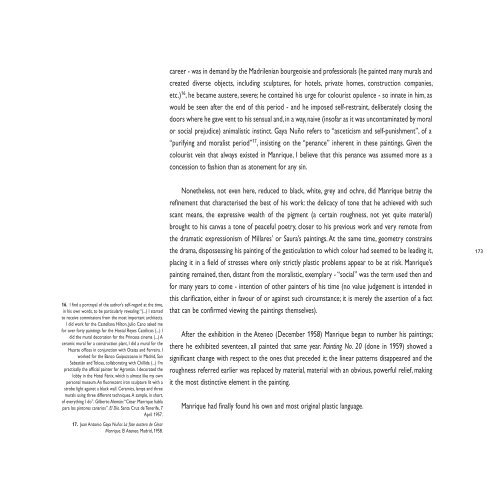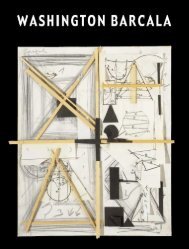VERSIÓN INGLESA ENGLISH VERSION - Fundación César Manrique
VERSIÓN INGLESA ENGLISH VERSION - Fundación César Manrique
VERSIÓN INGLESA ENGLISH VERSION - Fundación César Manrique
You also want an ePaper? Increase the reach of your titles
YUMPU automatically turns print PDFs into web optimized ePapers that Google loves.
16. I find a portrayal of the author’s self-regard at the time,<br />
in his own words, to be particularly revealing: “(...) I started<br />
to receive commissions from the most important architects.<br />
I did work for the Castellana Hilton, Julio Cano asked me<br />
for over forty paintings for the Hostal Reyes Católicos (...) I<br />
did the mural decoration for the Princesa cinema (...) A<br />
ceramic mural for a construction plant, I did a mural for the<br />
Huarte offices in conjunction with Oteiza and Ferreira. I<br />
worked for the Banco Guipuzcoano in Madrid, San<br />
Sebastián and Tolosa, collaborating with Chillida (...) I’m<br />
practically the official painter for Agromán. I decorated the<br />
lobby in the Hotel Fénix, which is almost like my own<br />
personal museum. An fluorescent iron sculpture lit with a<br />
strobe light against a black wall. Ceramics, lamps and three<br />
murals using three different techniques. A sample, in short,<br />
of everything I do”. Gilberto Alemán: “<strong>César</strong> <strong>Manrique</strong> habla<br />
para los pintores canarios”. El Día. Santa Cruz de Tenerife, 7<br />
April 1957.<br />
17. Juan Antonio Gaya Nuño: La fase austera de <strong>César</strong><br />
<strong>Manrique</strong>. El Ateneo. Madrid, 1958.<br />
career - was in demand by the Madrilenian bourgeoisie and professionals (he painted many murals and<br />
created diverse objects, including sculptures, for hotels, private homes, construction companies,<br />
etc.) 16 , he became austere, severe; he contained his urge for colourist opulence - so innate in him, as<br />
would be seen after the end of this period - and he imposed self-restraint, deliberately closing the<br />
doors where he gave vent to his sensual and, in a way, naive (insofar as it was uncontaminated by moral<br />
or social prejudice) animalistic instinct. Gaya Nuño refers to “asceticism and self-punishment”, of a<br />
“purifying and moralist period” 17 , insisting on the “penance” inherent in these paintings. Given the<br />
colourist vein that always existed in <strong>Manrique</strong>, I believe that this penance was assumed more as a<br />
concession to fashion than as atonement for any sin.<br />
Nonetheless, not even here, reduced to black, white, grey and ochre, did <strong>Manrique</strong> betray the<br />
refinement that characterised the best of his work: the delicacy of tone that he achieved with such<br />
scant means, the expressive wealth of the pigment (a certain roughness, not yet quite material)<br />
brought to his canvas a tone of peaceful poetry, closer to his previous work and very remote from<br />
the dramatic expressionism of Millares’ or Saura’s paintings. At the same time, geometry constrains<br />
the drama, dispossessing his painting of the gesticulation to which colour had seemed to be leading it,<br />
placing it in a field of stresses where only strictly plastic problems appear to be at risk. <strong>Manrique</strong>’s<br />
painting remained, then, distant from the moralistic, exemplary - “social” was the term used then and<br />
for many years to come - intention of other painters of his time (no value judgement is intended in<br />
this clarification, either in favour of or against such circumstance; it is merely the assertion of a fact<br />
that can be confirmed viewing the paintings themselves).<br />
After the exhibition in the Ateneo (December 1958) <strong>Manrique</strong> began to number his paintings;<br />
there he exhibited seventeen, all painted that same year. Painting No. 20 (done in 1959) showed a<br />
significant change with respect to the ones that preceded it; the linear patterns disappeared and the<br />
roughness referred earlier was replaced by material, material with an obvious, powerful relief, making<br />
it the most distinctive element in the painting.<br />
<strong>Manrique</strong> had finally found his own and most original plastic language.<br />
173
















![Becas y premios de la Fundación César Manrique [1997-2006]](https://img.yumpu.com/20766851/1/184x260/becas-y-premios-de-la-fundacion-cesar-manrique-1997-2006.jpg?quality=85)
